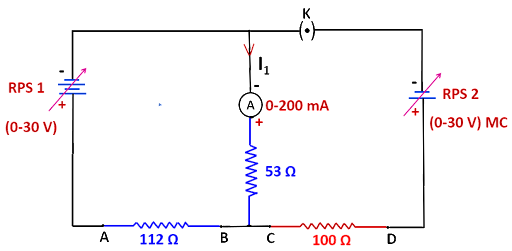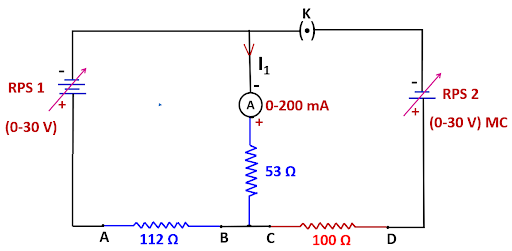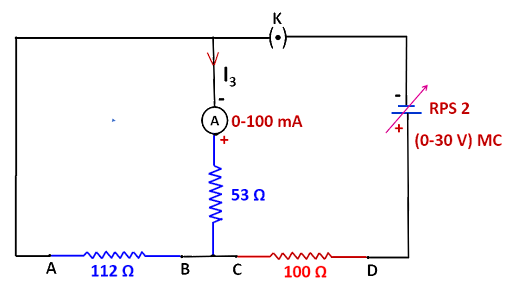
How do you verify the superposition theorem?
Answer
216k+ views
Hint:It is crucial to understand what the superposition theorem is before moving on to the issue. A circuit having several voltage and current sources is equal to the sum of simplified circuits employing just one of the sources, according to the superposition theorem.
Complete step by step solution:
Verification of superposition theorem:
The following experiment can be used to practically validate the superposition theorem.
Circuit diagram:

IMAGE: CIRCUIT 1
circuit 2:

circuit 3:

Procedure
1. As seen in the above diagram, connect the circuit.
2. As in circuit 1, set RPS1 and RPS2 to a specific voltage and record the ammeter reading.
3. Set the voltage to the same level by using RPS1 alone to short RPS2, and then record the ammeter reading as in circuit 2.
4. As demonstrated in circuit 3, set the same voltage by shorting RPS1 with RPS2 and recording the ammeter measurement.
5. The superposition theorem must be proven.
Verification
Theoretical values
\[{I_1} = {I_2} + {I_3}\] = 140
Practical values
\[{I_1} = {I_2} + {I_3}\] = 90 mA+ 50 mA = 140 mA
Superposition theorem is therefore practically and theoretically verified.
Note :To apply the superposition theorem to circuit currents and voltages, all of the components must be linear. It should be emphasised that since power is not a linear number, the superposition theorem does not apply to it.
Complete step by step solution:
Verification of superposition theorem:
The following experiment can be used to practically validate the superposition theorem.
Circuit diagram:

IMAGE: CIRCUIT 1
circuit 2:

circuit 3:

Procedure
1. As seen in the above diagram, connect the circuit.
2. As in circuit 1, set RPS1 and RPS2 to a specific voltage and record the ammeter reading.
3. Set the voltage to the same level by using RPS1 alone to short RPS2, and then record the ammeter reading as in circuit 2.
4. As demonstrated in circuit 3, set the same voltage by shorting RPS1 with RPS2 and recording the ammeter measurement.
5. The superposition theorem must be proven.
Verification
Theoretical values
| RPS | Ammeter Reading | ||
| 1 | 2 | ||
| Circuit 1 | 20 V | 10 V | \[{I_1} = 140\] |
| Circuit 2 | 20 V | 0 V | \[{I_2} = 90\] |
| Circuit 3 | 0 V | 10 V | \[{I_3} = 50\] |
\[{I_1} = {I_2} + {I_3}\] = 140
Practical values
| RPS | Ammeter reading | ||
| 1 | 2 | ||
| Circuit 1 | 20 V | 10 V | \[{I_1} = 140\] |
| Circuit 2 | 20 V | 0 V | \[{I_2} = 90\] |
| Circuit 3 | 0 V | 10 V | \[{I_3} = 50\] |
\[{I_1} = {I_2} + {I_3}\] = 90 mA+ 50 mA = 140 mA
Superposition theorem is therefore practically and theoretically verified.
Note :To apply the superposition theorem to circuit currents and voltages, all of the components must be linear. It should be emphasised that since power is not a linear number, the superposition theorem does not apply to it.
Recently Updated Pages
JEE Atomic Structure and Chemical Bonding important Concepts and Tips

JEE Amino Acids and Peptides Important Concepts and Tips for Exam Preparation

Electricity and Magnetism Explained: Key Concepts & Applications

Chemical Properties of Hydrogen - Important Concepts for JEE Exam Preparation

JEE Energetics Important Concepts and Tips for Exam Preparation

JEE Isolation, Preparation and Properties of Non-metals Important Concepts and Tips for Exam Preparation

Trending doubts
Understanding Electromagnetic Waves and Their Importance

Understanding the Wheatstone Bridge: Principles, Formula, and Applications

Formula for number of images formed by two plane mirrors class 12 physics JEE_Main

Step-by-Step Guide to Young’s Double Slit Experiment Derivation

Geostationary and Geosynchronous Satellites Explained

Inertial and Non-Inertial Frame of Reference Explained

Other Pages
MOSFET: Definition, Working Principle, Types & Applications

Explain the construction and working of a GeigerMuller class 12 physics JEE_Main

Electric field due to uniformly charged sphere class 12 physics JEE_Main

Clemmensen and Wolff Kishner Reductions Explained for JEE & NEET

Diffraction of Light - Young’s Single Slit Experiment

JEE Main 2023 January 29th Shift 2 Physics Question Paper with Answer Keys and Solutions




